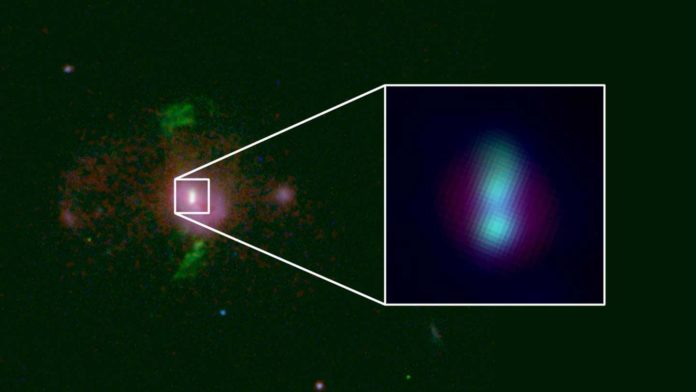Around 2.5 billion light-years away from Earth, Princeton scientists detected two supermassive black holes on a collision course.
Each black hole’s mass is more than 800 million times that of our sun. As these two are drawing closer together in a death spiral, they will start emitting gravitational waves rippling through space-time. Those cosmic ripples will join the so-far undetected background noise of gravitational waves from other supermassive black holes.
Indeed, even before the destined collision, the gravitational waves exuding from the supermassive black hole pair will dwarf those recently recognized from the mergers of a lot of smaller black holes and neutron stars.
Capturing distant worlds in the universe is as same as looking back in time, the pair belong to a universe 2.5 billion years younger than our own. Fascinatingly, that’s generally a similar amount of time the astronomers estimate the black holes will take to start creating powerful gravitational waves.
Andy Goulding, an associate research scholar in astrophysical sciences at Princeton who is the lead author on a paper said, “Collisions between enormous galaxies create some of the most extreme environments we know of, and should theoretically culminate in the meeting of two supermassive black holes, so it was incredibly exciting to find such an immensely energetic pair of black holes so close together in our Hubble Space Telescope images.”
Chiara Mingarelli, an associate research scientist at the Flatiron Institute’s Center for Computational Astrophysics in New York City, said, “Supermassive black hole binaries produce the loudest gravitational waves in the universe. Gravitational waves from supermassive black hole pairs “are a million times louder than those detected by LIGO.”
Princeton graduate student Kris Pardo, a co-author on the paper, said, “When these supermassive black holes merge, they will create a black hole hundreds of times larger than the one at the center of our galaxy.”
Lots of black holes, currently present in the universe, are emitting these gravitational waves, but even at light speed, the waves won’t reach us for billions of years. In the case of this newly detected pair, the due is still useful, and their discovery could aid scientists to gauge what number of nearby supermassive black holes are discharging gravitational waves that we could recognize now.
Jenny Greene, a professor of astrophysical sciences at Princeton and a co-author on the paper said, “It’s a major embarrassment for astronomy that we don’t know if supermassive black holes merge. For everyone in black hole physics, observationally this is a long-standing puzzle that we need to solve.”
The telltale gravitational waves generated by merging supermassive black holes are outside the frequencies currently observable by experiments such as LIGO and Virgo, which have detected the mergers of much smaller black holes and neutron stars.
Scientists hunting for the more massive gravitational waves from supermassive black hole collisions rely on arrays of individual stars called pulsars that act like metronomes, sending out radio waves in a steady rhythm. If a passing gravitational wave stretches or compresses the space between Earth and the pulsar, the rhythm will be thrown off slightly.
Detecting the gravitational wave background using one of these pulsar timing arrays takes patience and plenty of monitored stars. Only a few hundred nanoseconds might disrupt a single pulsar’s rhythm over a decade. The louder the background noise, the more massive the timing disruptions, and the quicker the detection will be made.
Goulding said, “Although supermassive black holes aren’t directly visible through an optical telescope like Hubble, they are surrounded by bright clumps of luminous stars and hot gas drawn in by the powerful gravitational tug. For its time in history, the galaxy harboring the newfound supermassive black hole pair is the most luminous galaxy in the universe.”
“What’s more, the galaxy’s core is shooting out two unusually large plumes of gas. When they pointed Hubble at it to uncover the origins of its spectacular gas clouds, the researchers discovered that the system contained not one but two massive black holes.”
Co-author Professor Michael Strauss, the associate chair of Princeton’s Department of Astrophysical Sciences said, “This is the first example of a close pair of such massive black holes that we’ve found, but there may well be additional binary black holes remaining to be discovered. The more we can learn about the population of merging black holes, the better we will understand the process of galaxy formation and the nature of the gravitational wave background.”
Journal Reference
- Andy D. Goulding, Discovery of a Close-separation Binary Quasar at the Heart of a z ~ 0.2 Merging Galaxy and Its Implications for Low-frequency Gravitational Waves. The Astrophysical Journal Letters, Volume 879, Number 2 DOI: 10.3847/2041-8213/ab2a14
